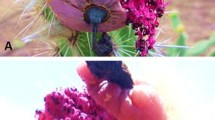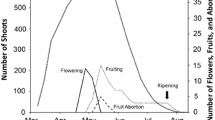Summary
In a series of field experiments using Costa Rican rain forest plants, we examined the effect of accessibility on fruit removal rates. We compared the effects of fruit placement in terminal and axillary infructescences on diurnal and nocturnal removal rates, visitation rates, and incidence of fruit damage. We used three different species of berries (Phytolacca rivinoides, Psychotria brachiata, and Psychotria pitteri) and worked in three different habitats (fallow fields, treefall gaps, and forest understory) and in two different seasons (July–September, a season of fruit abundance and December–January, a season of fruit scarcity.)
We found that in oldfields especially, diurnal removal rates by birds were significantly greater from axillary than from terminal infructescences. Nocturnal removal from axillary infructescences-presumably by rodents-is also occassionally significant. From these data, from observations on climbing ability and fruit use in captive rodents, and from reports in the literature, we suggest that rodents are significant sources of fruit and seed loss in tropical shrubs. We hypothesize that placement of the infructescence on the plant affects fruit removal by both seed-dispersing birds and by the less agile, often seed-destroying rodents. The balance between the two rates is an important component of a plant's dispersal success.
Diurnal fruit removal rates were higher during the season of fruit scarcity than during the season of fruit abundance and higher in old fields than in forest gaps or understory. Fruit damage rates-probably due to orthopterans-were slightly greater in gaps and understory than in old fields.
Similar content being viewed by others
References
Baird JW (1980) The selection and use of fruit by birds in an eastern forest. Wilson Bull 92:63–73
Baker HG (1973) Evolutionary relationships between flowering plants and animals in American and African tropical forests. In: BJ Meggars, E Ayensu and WD Duckworth (eds), Tropical forest ecosystems in Africa and South America: A comparative review. Smithsonian, Washington, DC p 145–159
Brown JH (1968) Activity patterns of some neotropical bats. J Mammal 49:754–757
Charnov EL (1976) Optimal foraging: the marginal value theorem. Theoret Pop Biol 9:129–136
Denslow JS, Moermond TC (in press) The interaction of fruit display and the foraging strategies of small frugivorous birds. In: WG D'Arcy (ed), Natural history of Panama and Central America. Missouri Botanical Garden, St. Louis, MO
Eisner T, Eisner H, Meinwald J, Sagan C, Walcott C, Mayr E, Wilson EO, Raven PH, Ehrlich A, Ehrlich PR, Carr A, Odum EP, Gans C (1981) Conservation of tropical forests. Science, NY 213:1314
Faegri K, van der Pijl L (1971) The principles of pollination ecology. Pergamon, New York
Fleming TH (1970) Notes on the rodent faunas of two Panamanian forests. J Mammal 51:473–490
Fleming TH (1973) The number of rodent species in two Costa Rican forests. J Mammal 54:518–521
Fleming TH (1974) The population ecology of two species of Costa Rican heteromyid rodents. Ecology 55:493–510
Foster MS (1977) Ecological and nutritional effects of food scarcity on a tropical frugivorous bird and its fruit source. Ecology 58:73–85
Foster RB (1973) Seasonality of fruit production and seed fall in a tropical forest ecosystem in Panama. Ph D thesis, Duke University, Durham, NC
Foster RB (in press a) The seasonal rhythm of fruit fall on Barro Colorado Island. In: E Leigh, Jr, AS Rand, and D Windsor (eds) Seasonal rhythms in a tropical forest. Smithsonian, Washington, DC
Foster RB (in press b) Famine on Barro Colorado Island. In: E Leigh Jr, AS Rand, D Windsor (eds). Seasonal rhythms in a tropical forest. Smithsonian, Washington, DC
Frankie GW, Baker HG, Opler PA (1974) Comparative phenological studies of trees in tropical wet and dry forests in the lowlands of Costa Rica. J Ecol 62:881–919
Heithaus ER, Fleming TH, Opler PA (1975) Foraging patterns and resource utilization in seven species of bats in a seasonal tropical forest. Ecology 56:841–854
Heithaus ER, Opler PA, Baker HG (1974) Bat activity and pollination of Bauhenia pauletia: plant-pollinator coevolution. Ecology 55:412–419
Herrera CM (1981) Fruit variation and competition for dispersers in natural populations of Smilax asper. Oikos 36:51–68
Hershkovitz P (1972) The recent mammals of the neotropical region: a zoogeographic and ecological review. In: A Keast, FC Erk, B Glass (eds), Evolution, mammals and southern continents. State University of New York, Albany p 311–431
Hilty SL (1980) Flowering and fruiting periodicity in a premontane rain forest in Pacific Colombia. Biotropica 12:292–306
Holdridge LR, Grenke WC, Hatheway WH, Liang T, Tosi JA (1971) Forest environments in tropical life zones: a pilot study. Pergamon, Oxford
Howe HF (1979) Fear and frugivory. Am Nat 114:925–931
Howe HF (in press) Fruit production and animal activity at two tropical trees. In: E Leigh, AS Rand, D Windsor (eds), Seasonal rhythms in a tropical forest. Smithsonian, Washington, DC
Howe HF, De Steven D (1979) Fruit production, migrant bird visitation, and seed dispersal of Guarea glabra in Panama. Oecologia (Berl) 39:185–196
Howe HF, Estabrook GF (1977) On intraspecific competition for avian dispersers in tropical trees. Am Nat 111:817–832
Howe HF, Vande Kerckhove GA (1979) Seed dispersal by birds and the fecundity of a tropical tree. Ecology 60:180–189
Howe HF, Vande Kerckhove GA (1980) Nutmeg dispersal by tropical birds. Science, NY 210:925–927
Janzen DH (1971) Euglossine bees as long distance pollinators of tropical plants. Science, NY 171:203–205
Jenkins R (1969) Ecology of three species of saltators in Costa Rica with special reference to their frugivorous diet. Ph D thesis, Harvard, Cambridge
Leck CF (1970) Comments on the seasonality of fruiting in the neotropics. Am Nat 104:583–584
Leck CF (1972) Seasonal changes in feeding pressures of fruit and nectar eating birds in the neotropics. Condor 74:54–60
McKey D (1975) The ecology of coevolved seed dispersal systems. In: LE Gilbert, PH Raven (eds), Coevolution of animals and plants. University of Texas, Austin p 159–191
Moermond TC, Denslow JS (in preparation) Fruit choice by tropical frugivorous birds: behavioral titration of berry quality against accessibility.
Opler PA, Frankie GW, Baker HG (1980) Comparative phenological studies of treelet and shrub species in tropical wet and dry forests in the lowlands of Costa Rica. J Ecol 58:167–188
Pyke GH (1981) Effects of inflorescence height and number of flowers per inflorescence on fruit set in waratahs (Telopea speciosissima). Aust J Bot 29:419–424
Ridley HN (1930) The dispersal of plants throughout the world. L Reeve, Ashford, Kentucky
Smythe N (1970) Relations between fruiting seasons and seed dispersal methods in a neotropical forest. Am Nat 104:25–35
Snow DW (1965) A possible selective factor in the evolution of fruiting seasons in tropical forest. Oikos 15:274–281
Snow DW (1971) Evolutionary aspects of fruit-eating by birds. Ibis 113:194–202
Stiles FG (1980) Evolutionary implications of habitat relations between permanent and winter resident land birds in Costa Rica. In: A Keast, ES Morton (eds), Migrant birds in the neotropics: ecology, behavior, distribution and conservation. Smithsonian, Washington, DC p 421–435
Thompson JN, Willson MF (1978) Disturbance and the dispersal of fleshy fruits. Science, NY 200:1161–1163
Vaughan TA (1978) Mammalogy. Saunders, Philadelphia
Willson MF, Thompson JN (in press) On the ecology of color in bird-dispersed fruits or why some fruits are red when they are “green” Can J Bot
Author information
Authors and Affiliations
Rights and permissions
About this article
Cite this article
Denslow, J.S., Moermond, T.C. The effect of accessibility on rates of fruit removal from tropical shrubs: An experimental study. Oecologia 54, 170–176 (1982). https://doi.org/10.1007/BF00378389
Received:
Issue Date:
DOI: https://doi.org/10.1007/BF00378389




